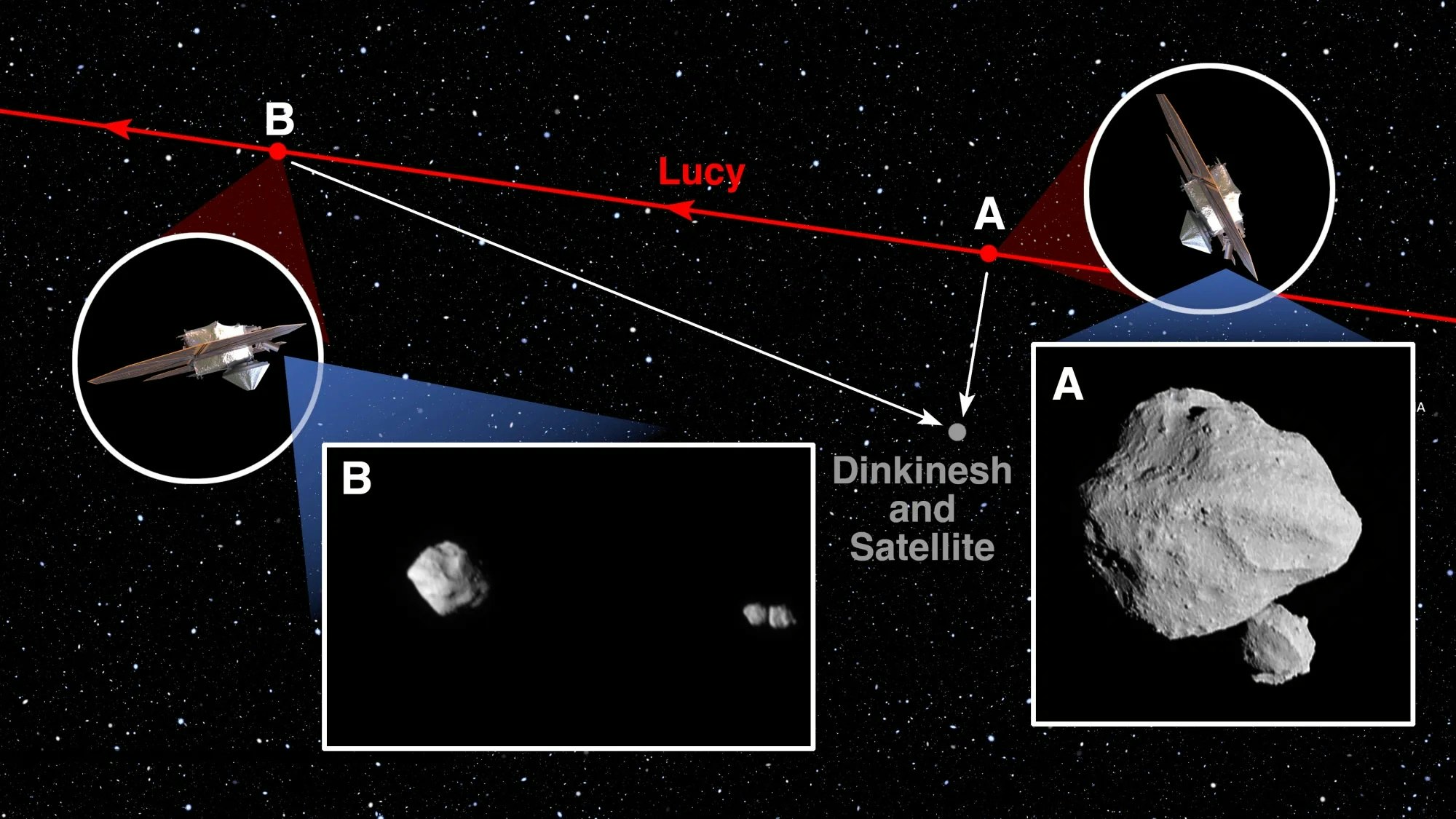
Asteroid Dinkinesh doesn’t have just one moonlet — it has two.
NASA’s Lucy spacecraft, which performed a fly-by rehearsal last week in preparation for its rendezvous with Jupiter’s Trojan moons in 2027, snapped a second image of a small rock in the asteroid belt named Dinkinish and made a surprising discovery.
As Lucy crept toward Dinkinesh, the science team expected to find a moonlet because the asteroid’s brightness kept changing due to something small casting a shadow across it. Turns out the half-mile-diameter asteroid was actually a proud parent of twin moonlets, dancing cheek-to-rocky-cheek around Dinkinesh itself. It’s the first time astronomers have ever found two such moonlets, known as a type of contact binary, orbiting an asteroid.
Surprise! It’s Twins!
When the Lucy spacecraft beamed home its first close-up image of asteroid Dinkinesh last week, scientists found a tiny moonlet about 0.15 miles wide orbiting the asteroid. The little moonlet, peeking out from behind Dinkinesh, looked like a lumpy, vaguely round space boulder in Lucy’s first image.
But six minutes later, Lucy snapped a second shot. By then, the spacecraft had traveled about 960 miles, and the moonlet had moved in its orbit around Dinkinesh. This new vantage point revealed that the roundish moonlet was actually actually a pair of moonlets, orbiting each other so closely that their surfaces were touching. Turns out Lucy’s first image had captured the moonlets end on end, meaning one moonlet was hiding behind the other.
“We never suspected anything so bizarre!” Southwest Research Institute’s (SwRI) and Lucy’s deputy project scientist John Spencer said in a recent statement.

A Moonlet Mystery
Contact binaries occur when two objects orbit each other so closely that they actually touch. Some contact binaries eventually end up smushed together into a single peanut-shaped object, but others manage to stick together while maintaining their own identities. Dwarf planet Arrokoth, out in the Kuiper Belt, is actually a contact binary; so is comet 67P/Churyomov-Gerasimenko, which the ESA’s Rosetta mission visited in 2014. Several asteroids are also contact binaries, and astronomers have even found some pairs of contact binary stars.
Despite the universe’s apparent zeal for twinning up, Dinkinesh’s moonlets are the first contact binary ever found orbiting an asteroid, and now scientists have a new puzzle to solve.
“In particular, I don’t understand why the two components of the satellite have similar sizes,” SwRI’s Hal Levison, Lucy’s principal investigator, said in a recent statement. Most of the contact binaries astronomers have found so far are lopsided, with one partner noticeably smaller than the other. “This is going to be fun for the scientific community to figure out.”

An Amazing Afterthought
Lucy’s Dinkinesh encounter wasn’t supposed to be all that exciting. Mission planners added the smallish asteroid orbiting at the inner edge of the asteroid belt to Lucy’s itinerary in January 2023, more than a year after the spacecraft launched. The goal was mostly to test the tracking system that Lucy uses to keep asteroids in focus during high-speed flybys.
Clearly, the tracking system worked.
The mission’s main goal is to study nine of the Trojan moons, a group of asteroids that orbit the Sun on the same path as Jupiter. One group of Trojans orbits 60 degrees behind Jupiter, and another group orbits 60 degrees ahead — at the planet’s L4 and L5 Lagrange points, where the gravitational pull of Jupiter and the Sun are in perfect balance.
In 2025 — after a December 2024 gravity-assist flyby of Earth — NASA’s Lucy will visit another main belt asteroid called 52246 Donaldjohanson. And if Dinkinesh is any indicator, it’s anyone’s guess what Lucy might find.







